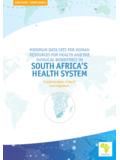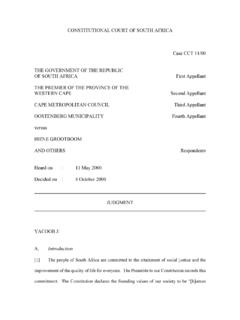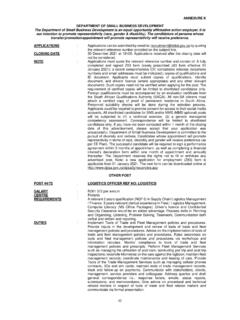Transcription of Public service delivery in South Africa
1 Public service delivery in South Africa Councillors and citizens critical links in overcoming persistent inequities By Sibusiso Nkomo Afrobarometer Policy Paper No. 42 | October 2017 Copyright Afrobarometer 2017 1 Introduction The August 2016 local government elections in South Africa sent an earthquake through the political class when the African National Congress (ANC) lost power in three major cities of the country. Coalition governments led by the Democratic Alliance (DA) and the Economic Freedom Fighters (EFF) took over the economic powerhouse, Johannesburg; the administrative capital and seat of the Presidency, Pretoria; and the biggest city in the Eastern cape and the country s vehicle-manufacturing hub, Nelson Mandela Bay.
2 Additionally, the DA grew its share of the vote to more than two-thirds in cape Town, the home of Parliament. In Ekurhuleni and other cities, the ANC created coalitions and barely clung to power. These elections can be seen as a milestone, indicating for the first time since 1994 that the ANC could lose power anywhere in the country. They also point to continuing perceptions of political and systemic weaknesses including a lack of qualified staff, capacity, professionalism, and accountability (Cooperative Governance and Traditional Affairs, 2009) at the local level of government, which deals most directly with citizens, is the coalface of service delivery , and thus may be most directly affected by Public dissatisfaction with Public services (Mungai, 2015; Institute for Security Studies, 2009).
3 Since 1994, South Africa s democratic governments have extended basic service provision to poorer areas of many cities, towns, and rural areas. For the first time, many citizens have enjoyed electricity and sewage systems that had previously been reserved for whites-only suburbs. According to the 2016 Statistics South Africa General Household Survey, electricity mains now reach 84% of the population. Water access is at 88%; 81% have access to improved sanitation; and only 4% are without a toilet facility. About two-thirds (65%) have their refuse removed once a week, compared to half or less before 1994 (Statistics South Africa , 2017). Nonetheless, numerous demonstrations and protests, often violent, have highlighted popular perceptions that local governments have not kept campaign promises of good service delivery most fundamentally, Nelson Mandela s 1994 promise of a better life for all.
4 Although services may be reaching people who never had them, is the quality of services inadequate to satisfy their recipients? Do service - delivery deficits reflect and perpetuate the apartheid-era spatial design of most towns, retarding racial and class integration and equality? This paper explores Public opinion on basic services provision at the local government level in South Africa . Building on Bratton (2012), which focused on local councillors responsiveness to constituents needs, I explore other factors that may influence Public perceptions of local service delivery , including contact with local councillors and councillors job performance and trustworthiness.
5 I also examine which actions, if any, citizens take when they see problems in their municipality. Afrobarometer survey Afrobarometer is a pan-African, non-partisan research network that conducts Public attitude surveys on democracy, governance, economic conditions, and related issues in Africa . Six rounds of surveys were conducted in up to 37 countries between 1999 and 2015, and Round 7 surveys (2017/2018) are currently underway. Afrobarometer conducts face-to-face interviews in the language of the respondent s choice with nationally representative samples. This policy paper draws mainly on data from the Afrobarometer Round 5 (2011) survey in South Africa , conducted by Citizen Surveys and the Institute for Democracy in South Africa .
6 (The Round 6 (2015) survey did not ask the full module of service - delivery questions.) The sample of 2,400 adults yields country-level results with a margin of error of +/-2% at a 95% confidence level. Previous surveys were conducted in South Africa in 2000, 2002, 2004, 2006, and 2008. Copyright Afrobarometer 2017 2 Key findings Half or more of South Africans said municipalities performed fairly badly or very badly in maintaining roads (56%), maintaining marketplaces (55%), managing land use (54%), and maintaining health standards (50%). Local governments scored slightly better on keeping communities clean (52% said this was handled fairly well or very well ).
7 Positive assessments of local services were more common among urban, more educated, employed, and white respondents. Perceptions that local councillors listen to their constituents and perform their jobs well were associated with positive assessments of how local government was handling service delivery . Living in rural areas and experiencing poverty were associated with negative evaluations of service delivery . About half (47%) of South Africans said they saw problems with the way local government was run, and substantial proportions said they took steps to address these problems by discussing or joining with other community residents and approaching religious, traditional, or community leaders.
8 Local government and service delivery in South Africa Under Section 152 of the South African Constitution of 1996, local government is the engine of basic service delivery . Local government is charged, among other things, with ensuring the provision of services to communities in a sustainable manner, promoting social and economic development, and promoting a safe and healthy environment (Constitution, 1996). Under a long-standing grading streamlined through the Organised Local Government Act (1997), South Africa has eight metropolitan cities, 44 district municipalities, and 226 local municipalities ( South African Government, 2017). All these types of municipalities have a core responsibility for water, sanitation, markets, refuse removal, and land management.
9 Owusu-Ampomah and Hemson (2004) describe service delivery as playing a greater role in local government in South Africa and other developing countries than in developed countries. Because of constitutional provisions and high poverty levels, they argue, service delivery in South Africa is seen as an instrument and social contract to create social inclusion and raise living standards of the poor majority previously excluded by the apartheid government. In line with this approach, Bratton and Sibanyoni (2006) found that many Africans see democratization in instrumental terms, through the lens of whether socioeconomic goods are delivered. In their analysis of 2006 Afrobarometer data, fewer than half of South Africa s adult citizens thought the then-new local government system was working well.
10 They also found that local government is often judged in personalized terms, especially based on whether local government councillors are perceived as doing their jobs well and as listening to constituents. Popular dissatisfaction with local government may be expressed at the ballot box, which Diamond and Morlino (2004) portray as the primary vertical-accountability mechanism. If elections are perceived as inadequate to enforce the obligation of elected political leaders to answer for their political decisions (Diamond & Morlino, 2004, p. 25), dissatisfaction may also be expressed in protests aimed at ensuring that local people get access to Public services .








